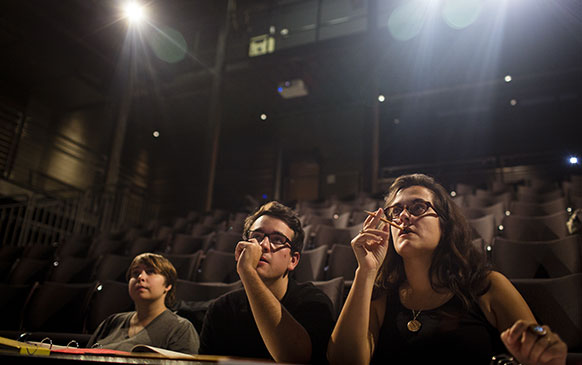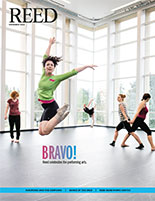
IRIS login | Reed College home Volume 92, No. 4: December 2013
Taking off the Gloves

DRAMATIC PAUSE. Assistant professor Kate Bredeson (right) takes stock of a rehearsal of Thornton Wilder’s Our Town in the brand new Diver Theatre in the Performing Arts Building. Sitting next to her are stage manager Jenn Lindell ’14 and assistant director Alan Cline ’14. Photo by Leah Nash
Prof. Kate Bredeson challenges students to make theatre that is both real and unreal.
By Randall S. Barton
In the first moments of class, assistant professor Kate Bredeson [theatre 2009–] succinctly nails her subject matter: “We are here to discover how the world shapes theatre and how theatre shapes the world.”
Theatre History I is sometimes referred to as the Hum 110 of theatre. As a means of introducing themselves, students are invited to recount a theatrical production that shook them to their core.
One student recalls a grade-school production of To Kill a Mockingbird where the issue of race was abstracted by the wearing of gloves.
“But why is that important?” presses Bredeson. “Sometimes we have to make a case for why theatre is necessary.”
“The use of gloves stripped away the conviction that judgment values put on race are somehow inherent,” the student replies. “It shows that the judgment values and all of the consequences are social constructions. We’ve constructed these values onto people because of something they have no control over, like who gets to wear the glove and who doesn’t.”
There may be debate in the workaday world about whether theatre is still relevant. There is no debate at Reed. Theatre is a discipline that demands both intellectual rigor and practical know-how—both thought and action. Students read 18th-century French plays for insight into the social problems and moral dilemmas of the time. They also learn tips for warding off stage fright. Some will make a career in the theatre; others will take what they have learned into domains that have little to do with the smell of the greasepaint or the roar of the crowd.
“Reed is a liberal arts school,” says Bredeson, “not a conservatory. In the theatre department we teach how to be a leader and make things work with very few resources. Learning how to collaborate and communicate are skills that will benefit any student.”
Indeed, experiments show that learning and problem-solving skills are greatly improved the longer individuals have been involved in theatre.
“Theatre teaches you to work with people and collaborate in a way that I’ve never experienced in anything else,” explains one of Bredeson’s students. “You have to learn how to work with all types of people, and that teaches you a lot about yourself along the way. Not only do you learn what types of personalities you mesh with—or should learn to work with better—you learn about your own type of personality, how you work with other people, and how you relate to them. These are skills that you can apply in pretty much any other aspect of your life.”
It’s an exciting time in the theatre department. Building on a strong foundational program established by Prof. Kathleen Worley [theatre 1985–] and Prof. Craig Clinton [theatre 1978–2010], the department has added three new colleagues in the last few years: assistant professor Kate Duffly, associate professor Peter Ksander, and assistant professor Melissa Schlachtmeyer. And then there’s the new Performing Arts Building.
“This building is a laboratory for making experiments, and these are experiences in community and, frankly, of the heart,” Bredeson says. “We all did fabulous work in Kaul Auditorium, the gym, and in the old theatre building. This is going to kick it up a notch.”
![]()
Bredeson is quick to note she is a director and dramaturg, not an actor. One suspects she was born with her commanding presence, but apart from being an avowed Francophile by the age of eight, she claims not to have been particularly theatrical as a child.
Her former student Dominic Finocchiaro ’11, who has gone on to produce plays in New York and who presented his play complex at Portland’s Just Add Water festival in July, said he would cast Katharine Hepburn to play Bredeson onstage. “Katharine Hepburn in her prime would best represent Kate’s fierce intellectualism and mixture of class, sass, wit, and fashion,” he says.
Growing up in Minnetonka, Minnesota, Bredeson was treated to performances at the Children’s Theatre of Minneapolis. Though she occasionally took part in grade-school productions, she was passed over for the title role in “Snow White,” and ended up playing a tree.
At Macalester College she planned to major in French and studio art. Her life changed when—thinking it would be an easy credit—she signed up for an acting class. Theatre opened a window on the world of politics, history, social roles, and gender. Recruited as a props assistant on a college production, Bredeson experienced the power of collaboration and realized she’d found a home in the theatre, though perhaps not as an actor.
“I was never able to get out of my head enough to just feel and be onstage in the moment,” she says.
Instead, she found herself thinking about the historical and cultural conditions surrounding the plays, and how theatre worked. Her mentor, Prof. Beth Cleary, suggested she try directing and helped her secure a one-year internship in dramaturgy at the Guthrie Theater.

LATEST COMMENTS
steve-jobs-1976 I knew Steve Jobs when he was on the second floor of Quincy. (Fall...
Utnapishtim - 2 weeks ago
Prof. Mason Drukman [political science 1964–70] This is gold, pure gold. God bless, Prof. Drukman.
puredog - 1 month ago
virginia-davis-1965 Such a good friend & compatriot in the day of Satyricon...
czarchasm - 4 months ago
John Peara Baba 1990 John died of a broken heart from losing his mom and then his...
kodachrome - 7 months ago
Carol Sawyer 1962 Who wrote this obit? I'm writing something about Carol Sawyer...
MsLaurie Pepper - 8 months ago
William W. Wissman MAT 1969 ...and THREE sisters. Sabra, the oldest, Mary, the middle, and...
riclf - 10 months ago